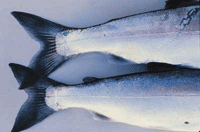

  |
|
What is the ESA? The Endangered Species Act was enacted by Congress in 1973 in response to an alarming decline of many animal and plant species. The ultimate goal of the ESA is to return endangered and threatened species to the point where they no longer need the law's protections. The ESA has three basic missions: (1) to identify species needing protection and the means necessary to protect and recover those species; (2) to prevent harm to listed species; and (3) to prevent and punish the so-called "taking" of listed species and destruction of their habitats. A species is listed as "endangered" if it is in danger of extinction, or "threatened" if it is likely to become endangered within the foreseeable future. The Act provides a variety of tools for saving species threatened with extinction. One widely used tool is the Habitat Conservation Plan which offers protection to landowners in exchange for a promise to manage land in a way that minimizes impacts to listed species. Another tool is adoption of protective regulations, commonly called the "4(d) rules" named after a section in the ESA. The National Marine Fisheries Service and U.S. Fish and Wildlife Service share responsibility for administration of the ESA. Generally, NMFS is responsible for species in marine environments and anadromous fish, while the USFWS oversees terrestrial and freshwater species and migratory birds.
Most of the salmon we buy in stores or restaurants is not from here. It's from Alaska where salmon habitat is still pristine or from fish farms in other countries. The relatively small amount of salmon from Washington State is from hatchery runs or healthy wild stocks.
If salmon are threatened, why are we allowing any fishing at all? Some populations of wild salmon are healthy and can sustain some harvest pressure. Others are declining and must be protected. Hatchery fish meanwhile, are raised to provide fishing opportunities throughout Washington. |
|
|
|||
|
Hatchery-grown salmon with few exceptions are not considered native and are not protected under the ESA. Many hatchery fish are now "marked" by clipping the adipose fin on their upper body to distinguish them from wild salmon. Fishers can now identify the hatchery fish they can keep while protecting wild salmon. |
 |
||
|
What is a watershed? You're standing in one right now. A watershed is the area of land that water flows across or under on its way to a river, lake or ocean. The water travels over the surface and across farms, forest-land, suburban lawns and city streets. Or it seeps into the soil and travels as ground water. You live in a watershed, even if there's no body of water anywhere near your home.
The riparian zone, or buffer, is the green area next to the water. These vegetative strips of grass, shrubs and trees protect stream banks from erosion and filter pollutants out of stormwater before they can reach the stream. Trees and shrubs along stream banks also provide shade to keep water cool for salmon.
If I don't live on a stream or river, will I be affected by salmon recovery? Salmon habitat really includes the entire watershed, which is all of the land that drains to the stream, river or estuary that salmon live in. Because streams are very sensitive to changes in the land throughout the watershed, even though you may live miles away from the nearest stream, your actions affect the stream and its salmon. Your fertilizer, weed killer, and motor oil can wash off in the rain and enter the streams. If you remove tress or increase the amount of land covered by asphalt and concrete, that means that less water will soak into the ground and more water will flood into the stream when it rains, causing flooding and erosion and scouring away spawning gravels. No matter where you live, you will probably be affected in some way.
Fresh water is far more scarce than many of us realize. Only one quarter of one percent of the Earth's water supply is available as drinking water at any given time. About 97 percent of the Earth's water is in our oceans and 2 percent is frozen. Here in Washington we double our water consumption in the summer - the same time no new rainfall is entering our reservoirs and water tables. This is also a critical time when fish need water.
There is a lot of talk about "habitat" in salmon recovery discussions. Just what is habitat? Simply said it's what fish need to live; it's where they live. It's clean, cool water in the right amounts. It's the trees and shrubs that shade streams and help filter pollutants that enter the water. And because fish and people share the same habitat, everything we do in managing our land and water affects salmon. |